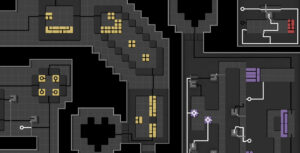0PLAYER
 Here’s something new and really cool that became my obsession for a few days last week and which I’ve been mulling over ever since. At heart, 0PLAYER is a game about sliding tiles around on a grid to form connections between things, according to mechanics you discover over the course of the game, solving mini-puzzles that together form one large puzzle. Except it’s not interactive at all. The game is just a static image.
Here’s something new and really cool that became my obsession for a few days last week and which I’ve been mulling over ever since. At heart, 0PLAYER is a game about sliding tiles around on a grid to form connections between things, according to mechanics you discover over the course of the game, solving mini-puzzles that together form one large puzzle. Except it’s not interactive at all. The game is just a static image.
I suppose this kind of instructionless picture puzzle isn’t without precedent. You see similar things in puzzle hunts and the books of Blaž Gracar (LOK, etc.) But the fact that it’s presented like a game in a familiar genre gives it a different feel from those, and more importantly, acts as a source of information: familiar genre means familiar mechanics and familiar conventions. There were times when I realized that my guesses about the mechanics must be in error not because a puzzle seemed unsolvable, but because it didn’t make sense for it to be a puzzle, either because it seemed trivially easy, or because there were elements that seemed to simply serve no function, either as problems or solutions. In short, solving the game requires thinking like a designer — asking not just “How can I solve this puzzle?” but “Why is this puzzle the way it is?”
Please understand that there is no explicit confirmation of solutions. The game obviously can’t do it, being a static image, and there’s no external resource like a website where you type in keywords somehow extracted from the completed grid or whatever. Nor is there any logical necessity to the solutions: you can come up with any number of ideas for what the goals are, and for mecahics that make those goals achievable. And yet the correct answers somehow manage to be as self-confirming as a cryptic crossword. Once you have an inkling of what it’s trying to do, it’s obviously right. It’s easy to think that the essence of a puzzle is obfuscation, about making things difficult to understand, but this is a mistake. Puzzles are all about communication, about inducing a realization in the solver. This game is a great example of that, and it’s downright impressive that it pulls it off under its constraints.
There’s inevitably been some people asking if there will be an interactive version, but such a thing would spoil the game we have. Not just because it would erase the ingenuity of overcoming its limitations as I’ve just described, but because it would introduce new limitations. In the game as it stands, the player is free to roam: there’s some definite gating and ordering in what you need to understand when, but you can at least look at all the puzzles and try to learn from them, even if you can’t actually solve them yet. Also, the rather abstract and theoretical nature of the gameplay lets you skip over repetitive actions, like the stereotypical mathematician saying “This reduces to a problem that has already been solved”. Yes, interactive games have ways to get the same effect, like opening shortcuts back to the hub and the like, but this game doesn’t indulge in such inelegance because it doesn’t need to.
I’ll admit that there was one bit where the communication failed for me personally: there was a mechanic that so thoroughly violated my most basic assumptions about how tiles move that I found myself forming increasingly wild theories of epicyclic complexity rather than getting on the right track. This is the one place where I had to consult the hints. Yes, the game comes with hints, but crucially, they don’t explain everything. Each hint set goes into progressively greater detail explaining one mechanic, but doesn’t actually give the solution to any puzzles. That’s because, in a peculiar inversion, the puzzle solutions aren’t actually all that important. Even the critical path puzzles are skippable. The puzzles are really just clues. The mechanics are the solutions.
 Comments(1)
Comments(1)
“The puzzles are really just clues. The mechanics are the solutions.” That’s such a great insight, damn. Well stated!